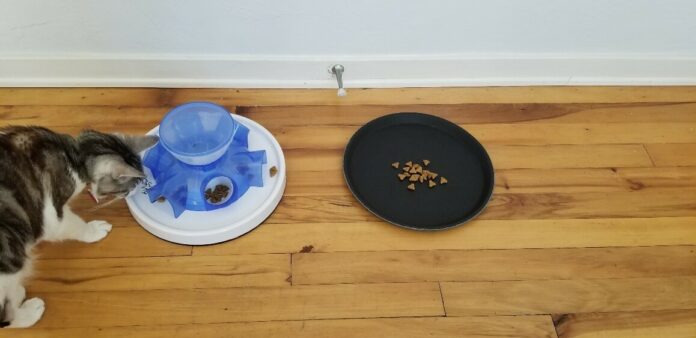While contrafreeloading is a phenomenon widely observed in confined animals, recent research suggests that domestic cats won’t choose to do so
Dogs, pigs, birds, wolves, rodents and even giraffes all have something in common—when given the choice, they prefer to work for their food rather than getting it for free, a phenomenon known as contrafreeloading. The outlier? Domestic house cats.
According to a recent press release, a study conducted by cat behaviorist Mikel Delgado, professor of clinical animal behavior at UC Davis Melissa Bain and veterinary technician assistant Brandon Sang Gyu Han, found that “cats would rather eat from a tray of easily available food rather than work out a simple puzzle to get their food.”
The study came about when Delgado was working on postdoctoral research at UC Davis.
“I was familiar with a study from about 50 years ago that concluded that cats won’t choose to contrafreeload,” Delgado said. “But there were some issues—only six cats were studied, it was done in a lab, the cats were food deprived. The thing is that cats hunt, which is working for food, so it seemed contradictory that they wouldn’t contrafreeload.”
Because of this, Delgado and fellow researchers hypothesized that “cats would contrafreeload in the home environment when given a choice.” They also hypothesized that more active cats would be more likely to contrafreeload.
Instead, they found that cats ate more free feed from the tray than the puzzle, made more “first choices” to approach and eat from the tray, and that “there was no relationship between activity and contrafreeloading.”
Bain explained that results like these, that do not support the hypothesis, are known as negative results. However, she emphasized that this type of finding is still important.
“When studies don’t get the results they wanted, it doesn’t match their hypothesis, a lot of times they don’t publish,” Bain said. “But negative results or no results are just as important, and should absolutely be published […] Other animals choose to work for food—but not finding that in our study didn’t mean that the result of this study is bad.”
Bain went on to describe why she found the prospect of the study exciting, and the importance she believes it holds.
“I really like cats, and I like clinically applicable studies that are applicable on day one,” Bain said. “My world is very clinically oriented. Helping people with their pets in their homes. I look for what’s related to the human-animal bond and related to the animal’s welfare. And this is one of those studies that can improve their welfare—did they lose weight? Are they less stressed?”
While this study didn’t necessarily find contrafreeloading to have a defined positive impact on cats, previous research Delgado has done shows that food puzzles can be an important enrichment tool for confined animals.
Tony Buffington was a co-author alongside Delgado on a 2016 paper which presented case studies where food puzzles aided cats with problems such as weight loss and anxiety.
According to Buffington, via email, the goal was to “equip veterinary professionals with the tools to assist clients in the use of food puzzles for their cats as ways to support feline enrichment, physical health and emotional wellbeing.”
As well as presenting “evidence-based studies of food puzzles,” Buffington said that the authors of the paper also provided examples of the benefits of puzzles from their own veterinary and behavioral practices.
Although food puzzle studies on cats are somewhat rare, according to Buffington, the practice of providing enriching activities for confined animals has been well-documented and studied on a variety of zoo animals.
. “Food puzzles, or what’s sometimes called foraging enrichment, offers animals an opportunity to express behaviors they maybe don’t have access to in their closed environment, behaviors that are natural to them,” Delgado said.
Delgado explained that this could include spreading food across the ground for animals who typically forage, filling a pumpkin with food on Halloween so that an animal has to break it open to access it or any number of other creative methods of presenting food to a confined animal.
Often, zookeepers attempt to match the enrichment activity to an animal’s natural behaviors in the wild. According to Delgado, the failure of food puzzles traditionally presented to domestic cats to simulate their natural hunting style of sit-and-wait predation could be one flaw in the contrafreeloading study. It is possible that if a puzzle were made to move like prey, cats could be more inclined to work for their food by catching their “prey.”
However, Delgado went on to say that even food puzzles that imperfectly simulate natural behavior can benefit animals by providing them with mental stimulation.
“I wouldn’t want to say that just because it doesn’t simulate their natural hunting or foraging style exactly, it’s useless,” Delgado said.
Other than trying a new type of food puzzle, the paper presented several ideas for where to go next in research, especially to determine why domestic cats might be adverse to contrafreeloading. While Delgado has moved on from her research position, she invites other researchers to continue her work on the topic.
Buffington offered his opinion on why continuing to learn about food puzzles is important for the welfare of confined animals.
“I think that those who advocate [for] confin[ing] cats accept the responsibility of providing them an environment that meets their behavioral needs to ensure [good] health and welfare for them,” Buffington said. “I hope that food puzzles, and the learnings people gain when using them properly, help them discharge that responsibility.”
Written by: Sonora Slater — science@theaggie.org





